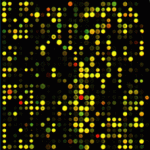Genomics
|
24 april 2012 07:18:31 |
| A framework genetic map for Miscanthus sinensis from RNAseq-based markers shows recent tetraploidy (BMC Genomics) |
|
Tweet Background:
Miscanthus (subtribe Saccharinae, tribe Andropogoneae, family Poaceae) is a genus of temperate perennial C4 grasses whose high biomass production makes it, along with its close relatives sugarcane and sorghum, attractive as a biofuel feedstock. The base chromosome number of Miscanthus (x = 19) is different from that of other Saccharinae and approximately twice that of the related Sorghum bicolor (x = 10), suggesting large-scale duplications may have occurred in recent ancestors of Miscanthus. Owing to the complexity of the Miscanthus genome and the complications of self-incompatibility, a complete genetic map with a high density of markers has not yet been developed.
Results:
We used deep transcriptome sequencing (RNAseq) from two M. sinensis accessions to define 1536 single nucleotide variants (SNVs) for a GoldenGateTM genotyping array, and found that simple sequence repeat (SSR) markers defined in sugarcane are often informative in M. sinensis. A total of 658 SNP and 210 SSR markers were validated via segregation in a full sibling F1 mapping population. Using 221 progeny from this mapping population, we constructed a genetic map for M. sinensis that resolves into 19 linkage groups, the haploid chromosome number expected from cytological evidence. Comparative genomic analysis documents a genome-wide duplication in Miscanthus relative to Sorghum bicolor, with subsequent insertional fusion of a pair of chromosomes. The utility of the map is confirmed by the identification of two paralogous C4-pyruvate, phosphate dikinase (C4-PPDK) loci in Miscanthus, at positions syntenic to the single orthologous gene in Sorghum.
Conclusions:
The genus Miscanthus experienced an ancestral tetraploidy and chromosome fusion prior to its diversification, but after its divergence from the closely related sugarcane clade. The recent timing of this tetraploidy complicates discovery and mapping of genetic markers for Miscanthus species, since alleles and fixed differences between paralogs are comparable. These difficulties can be overcome by careful analysis of segregation patterns in a mapping population and genotyping of doubled haploids. The genetic map for Miscanthus will be useful in biological discovery and breeding efforts to improve this emerging biofuel crop, and also provide a valuable resource for understanding genomic responses to tetraploidy and chromosome fusion. |
| 253 viewsCategory: Genomics |
 Complete genome sequence, lifestyle, and multi-drug resistance of the human pathogen Corynebacterium resistens DSM 45100 isolated from blood samples of a leukemia patient (BMC Genomics) Complete genome sequence, lifestyle, and multi-drug resistance of the human pathogen Corynebacterium resistens DSM 45100 isolated from blood samples of a leukemia patient (BMC Genomics)Characterization of the transcriptome of an ecologically important avian species, the Vinous-throated Parrotbill Paradoxornis webbianus bulomachus (Paradoxornithidae; Aves) (BMC Genomics) 
|
| blog comments powered by Disqus |
MyJournals.org
The latest issues of all your favorite science journals on one page
The latest issues of all your favorite science journals on one page



